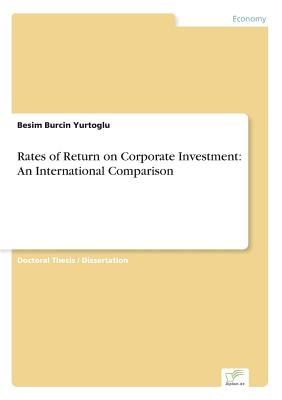
- We will send in 10–14 business days.
- Author: Besim Burcin Yurtoglu
- Publisher: Diplom.de
- Year: 2000
- Pages: 112
- ISBN-10: 3838626133
- ISBN-13: 9783838626130
- Format: 14.8 x 21 x 0.7 cm, softcover
- Language: English
- SAVE -10% with code: EXTRA
Reviews
Description
Inhaltsangabe: Abstract: In the 1980s many U.S. companies restructured. This was a reaction to the striking deterioration in the performance of 1970s. In the 1990s studies emerged making similar observations for the European companies (De Jong, 1995). Explanations for this poor performance often focus an the quality of corporate investment decisions. In particular, several authors (Marris, 1964; Mueller, 1972) suggested convincing theoretical arguments which were backed with empirical support (Baumol et al (1970), Grabowski and Mueller (1975), Shinnar et al (1989), and Mueller and Reardon (1993)) that managerial discretion was at the heart of this problem. This paper provides estimates of rates of return an investment using a newly developed efficient markets approach by D.C. Mueller and E. Reardon (1993). This technique relates a firm's investment performance relative to cost over a given period of time to the change in its market value. Making assumptions about efficiency of the capital markets and depreciation, it enables to infer a rate of return relative to the cost of funds which are used to finance investment. We present this measure of investment performance (c) for 2868 companies from 27 countries over the 1984--1994 period. Though estimates for the whole sample show a large fraction of firms earning returns to investment below the opportunity cost of capital for their owners over the last decade, individual countries and industries demonstrated considerable heterogeneity in investment performance. The results suggest for the U.S. a better investment performance in the last decade than over the 1970s. The best performance comes from the Asian companies, whereas the European and Scandinavian companies occupy a place between these two country groups. In addition to this, we can make three important observations. First, we are able to establish strong empirical evidence that a large number of companies in the sample have invested above the levels that we
EXTRA 10 % discount with code: EXTRA
The promotion ends in 18d.20:59:02
The discount code is valid when purchasing from 10 €. Discounts do not stack.
- Author: Besim Burcin Yurtoglu
- Publisher: Diplom.de
- Year: 2000
- Pages: 112
- ISBN-10: 3838626133
- ISBN-13: 9783838626130
- Format: 14.8 x 21 x 0.7 cm, softcover
- Language: English English
Inhaltsangabe: Abstract: In the 1980s many U.S. companies restructured. This was a reaction to the striking deterioration in the performance of 1970s. In the 1990s studies emerged making similar observations for the European companies (De Jong, 1995). Explanations for this poor performance often focus an the quality of corporate investment decisions. In particular, several authors (Marris, 1964; Mueller, 1972) suggested convincing theoretical arguments which were backed with empirical support (Baumol et al (1970), Grabowski and Mueller (1975), Shinnar et al (1989), and Mueller and Reardon (1993)) that managerial discretion was at the heart of this problem. This paper provides estimates of rates of return an investment using a newly developed efficient markets approach by D.C. Mueller and E. Reardon (1993). This technique relates a firm's investment performance relative to cost over a given period of time to the change in its market value. Making assumptions about efficiency of the capital markets and depreciation, it enables to infer a rate of return relative to the cost of funds which are used to finance investment. We present this measure of investment performance (c) for 2868 companies from 27 countries over the 1984--1994 period. Though estimates for the whole sample show a large fraction of firms earning returns to investment below the opportunity cost of capital for their owners over the last decade, individual countries and industries demonstrated considerable heterogeneity in investment performance. The results suggest for the U.S. a better investment performance in the last decade than over the 1970s. The best performance comes from the Asian companies, whereas the European and Scandinavian companies occupy a place between these two country groups. In addition to this, we can make three important observations. First, we are able to establish strong empirical evidence that a large number of companies in the sample have invested above the levels that we


Reviews